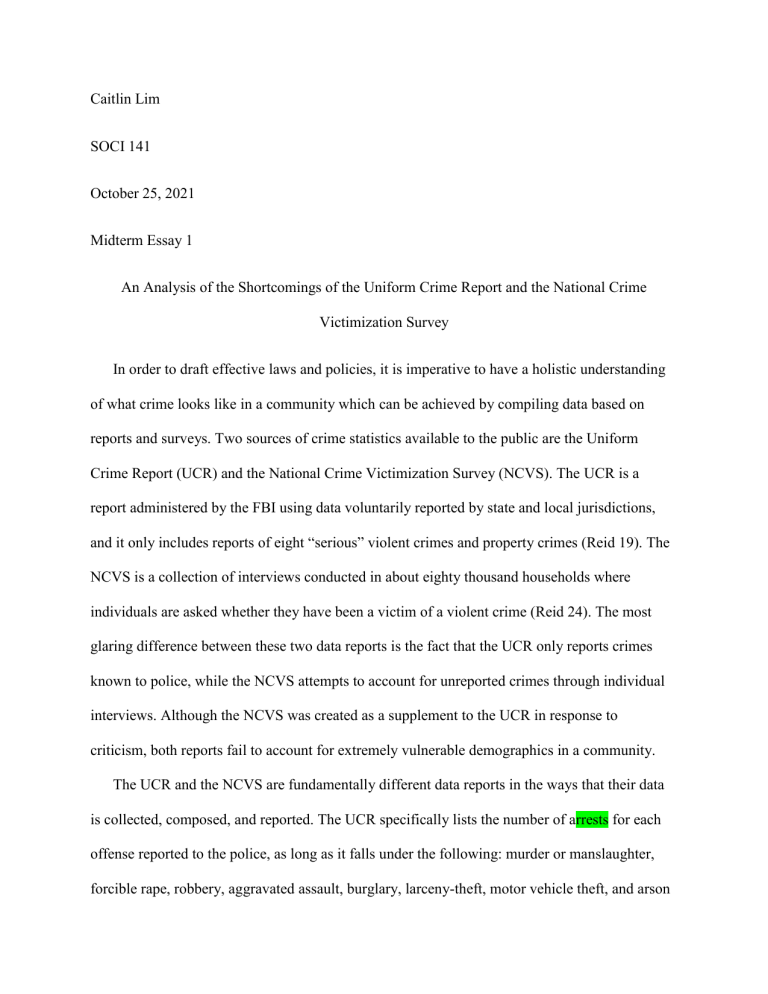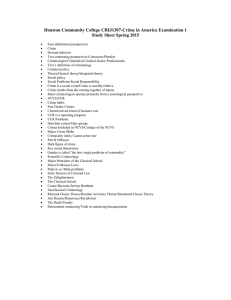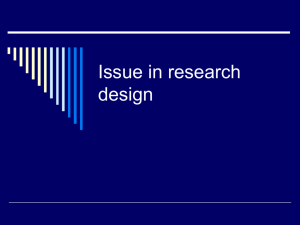
Caitlin Lim SOCI 141 October 25, 2021 Midterm Essay 1 An Analysis of the Shortcomings of the Uniform Crime Report and the National Crime Victimization Survey In order to draft effective laws and policies, it is imperative to have a holistic understanding of what crime looks like in a community which can be achieved by compiling data based on reports and surveys. Two sources of crime statistics available to the public are the Uniform Crime Report (UCR) and the National Crime Victimization Survey (NCVS). The UCR is a report administered by the FBI using data voluntarily reported by state and local jurisdictions, and it only includes reports of eight “serious” violent crimes and property crimes (Reid 19). The NCVS is a collection of interviews conducted in about eighty thousand households where individuals are asked whether they have been a victim of a violent crime (Reid 24). The most glaring difference between these two data reports is the fact that the UCR only reports crimes known to police, while the NCVS attempts to account for unreported crimes through individual interviews. Although the NCVS was created as a supplement to the UCR in response to criticism, both reports fail to account for extremely vulnerable demographics in a community. The UCR and the NCVS are fundamentally different data reports in the ways that their data is collected, composed, and reported. The UCR specifically lists the number of arrests for each offense reported to the police, as long as it falls under the following: murder or manslaughter, forcible rape, robbery, aggravated assault, burglary, larceny-theft, motor vehicle theft, and arson (Reid 19). On the other hand, the NCVS lists the number of victims who self-report in an interview, regardless of police report, but it excludes victims of murder and arson, as well as victims under the age of 12 (Reid 23). Since NCVS interviews are conducted individually, they are able to include an estimate of domestic violence and intimate personal violence. It is important to distinguish the number of arrests from the number of victims because it provides policymakers with an idea of the crimes that go unreported – otherwise known as the “dark figure of crime” (Lecture 10/4). If there are more victims of a particular crime than there are arrests, then this indicates that these crimes are underreported or the law enforcement institutions are not reporting them as crimes. The NCVS provides a valuable picture of what crimes may go underreported by the UCR, but neither the NCVS nor the UCR are able to resolve the fact that the nature of both reports exclude vulnerable demographics from their data. The sample size of both the UCR and the NCVS explicitly exclude specific data samples from their collection, and this results in the further exclusion of vulnerable communities who need policy reform the most. Since the UCR has no way of accounting for crimes that go unreported, criminals who intimidate their victims into silence are severely undercounted. For example, victims of forcible rape often remain silent and do not report to the police out of fear of being targeted by their rapist or out of fear of not being taken seriously. This results in an undercount of the number of rape crimes. The UCR also fails to account for crimes committed against populations who do not have trust in their law enforcement institution. For example, undocumented immigrants may avoid reporting crime to the police out of fear of deportation, rendering crime against their demographic severely underreported. The NCVS, in attempt to respond to these shortcomings, conducts interviews from a “nationally representative sample of US households,” but it explicitly excludes victims of crime who are under the age of 12, victims who live in institutions, and homeless victims (Reid). Ironically, children, the elderly, and the homeless are predisposed to underreport crime due to the fact that they have less access to law enforcement resources and are less likely to be taken seriously. Therefore, neither the UCR nor the NCVS are able to provide policymakers with an accurate idea of crime against these demographics, rendering these populations more vulnerable to repeated victimization. Although the whole purpose of reporting crime statistics is to draft policy that would reduce crime, both the UCR and the NCVS leave provide incomplete pictures of crime committed against society’s most vulnerable communities. The NCVS, created as a response to criticisms of underreporting in the UCR, is able to provide valuable context of how crime is reported in a community, but both reports still fail to protect the people the need policy reform the most. Taking a more equitable approach to crime statistics is the appropriate response to the lack of attention paid to underrepresented demographics. The primary shortcoming of the NCVS is its exclusion of children, the elderly, and the homeless. Hence, the best way to equitably report crime is to reach out to these specific communities.


